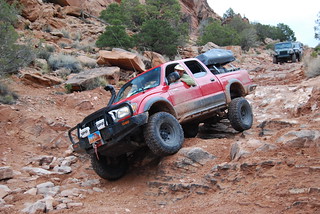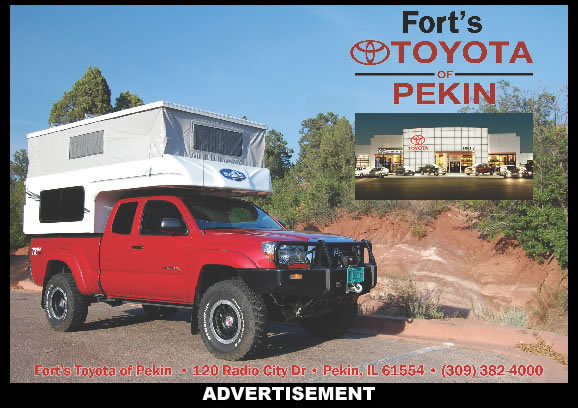Notes:
As mentioned the supercharger was not a deal breaking accessory I needed or wanted to have when truck shopping, however, in hindsight I don't know that I would have it any other way. The 1st generation Tacoma Double-Cab is only available in an automatic transmission package, and while the automatic transmissions are fairly bulletproof, they, like all automatics, rob much-needed power-- particularly on a heavily-laden truck spinning large tires. Many choose to re-gear the axles to get the power back but the supercharger more than makes up for the power loss, allowing me to easily maintain speeds even up the steepest grades and headwinds. My ideal package would be a manual truck with the supercharger, but it just wasn't an option and truth be told I've really come to love the automatic.
Where to start with the snorkel? Either you like them or you don't. For me the priority of additions has far less to do with aesthetics and far more to with practicality: and sometimes that practicality means planning for things that 'could' happen, even if rare. Snorkels don't only allow for an increased water fording depth but they also allow for cleaner, cooler air to your engine. I recently wrote a snorkel specific article for the Tacoma Magazine, you can read that article here: http://www.tacomamag.com/rokstories-...lume-1-issue-1
The Helton Hot Water Shower system is typically able to heat water upwards of 150 degrees, far too hot for a shower. A typical installation utilizes a manual control valve under the hood that limits the amount of coolant entering the heat exchanger. Rather than use the manual control valve I opted to mount the heat exchanger inline with the stock heater control valve (controlled by the knob on the dash and used to control the heater temperatures inside the cab). In this manner I am able to adjust my shower output temps using my dash controls, with no tangible side effects on the stock heater system. Showers are just 'one of those things', sort of like a 12V fridge or a portable welder. Until you need one or use one, they have little or no real value to you. Well, I can promise you I've sold more showers by loaning out a bar of soap and some hot water than I have giving my sales spiel to a would-be customer-- simply put they sell themselves when in use. My wife was the first one to say "we'll never use that thing", but after having installed one under the hood of my FJ40, fast forward five years and she is the one hooking the thing up at the end of a dusty day on the trail. Even a good face wash-down is a godsend.
I've bounced back and forth between CO2 tanks and actual mounted compressors, and I came close to mounting a CO2 bottle in the bed of the Tacoma as I had with my older truck, but it just doesn't work for the way I often load this truck, taking up precious space in an already limited short-bed truck. Most of the time my tank would just stay packed away in a Pelican case, neither convenient nor space saving, and I had convinced myself I would find a better solution. That solution ended up being a different air source altogether, an ARB CKMA12 compressor. Again, I had a fair amount of experience with these through customer installs since they were first introduced a few years back but I'm still running an older ARB RDCKA in my FJ40 so it wasn't something I had personally used over and over. I wired it to a water-proof switch in my fuse block/dual battery solenoid panel under the hood. That way I can turn it on and off without needing keys in the ignition, and even if left on its air-tight so it will just cycle for a few seconds and turn off. The compressor has proven completely adequate for airing up tires, but on a recent float trip I realized I'm not quite done with my love of CO2 as the volume available from this ARB compressor was inadequate for filling rafts/tubes. No doubt I will leave the compressor mounted under the hood but I'm still loosely considering a CO2 mount as well.
On to the fridge, where to start. Some might consider this a general accessory, however I consider it an appliance, and it spends enough of its life in the back of the truck to be considered a permanent fixture. You can read more on my fridge thoughts here: 12V Freezer-Fridges - Do they bring the heat?
Parts Acquisition:
I'm fortunate to have many of these parts 'on the shelf' at my shop (Cruiser Outfitters) so when it comes time to update or repair something I don't have to look too far. The National Luna and Front Runner products came from my good friend Paul at Equipt Expedition Outfitters, the communication gear came from Communication Products and the stereo audio-video setup came from the king of wires, Ryan at Ratio Electronics.
Repairs & Failures:
Steering Rack: I've gone through three now, one of which had horrible play right out of the Toyota box-- we didn't even get it installed before we were pulling it back off to swap with another factory re-manufactured unit. When I replaced the first rack I installed the Energy Suspension Poly Bushings and have swapped them to the subsequent racks. I'm adequately satisfied with the OEM new steering racks, but I've been less than satisfied with the quality and longevity of the re-manufactured steering racks. I should note that on stock height trucks or lifted trucks seldom used off-road, the steering racks seemingly last indefinitely. However, add a taller suspension, with increased tie rod angles, combined with larger tires and heavy off-road use, and they will likely need replacement every 30-50k miles. It should be noted that they don't fail outright, rather they get sloppy and you'll notice sloppy steering. So while they might get a bit loose, they are not likely to leave you stranded or leave the truck un-drivable.
CV Shafts: My stock shafts started clicking at full lock turns at 90,000 miles-- these were replaced by the dealership with OEM reman's under the 100k factory warranty. Clicking is gone but following the CV replacement I started dealing with leaking at the diff seals. Along with the steering rack issues, CV axle issues are directly proportional to the suspension lift, a necessary evil in most cases. With 90,000 miles on the truck, and 55,000 of them with the lift kit installed and used in anger, “clicky” operation is to be expected, and to some extent accepted. While increased CV axle wear is common on lifted vehicles, more common is the CV boot tearing or ripping. Thankfully neither issue is prone to leave you stranded and will give you plenty of notice before needing attention.
CV/Diff Seals: My issues started when the dealer warrantied the CV shafts. Since this time I've had to replace the passenger side CV/diff seal on the passenger side a couple of times. The dealer warrantied their work the first two times but I decided to address it myself. I actually installed a second seal in the passenger differential tube, so far so good but they usually don't leak for ~25k miles. It’s not a common issue and I've yet to run across a customer having similar issues on identical built Tacoma's. Jury is still out on why I was dealing with so many leaks.
Related Articles
Fan Blower Motor: The unit started squeaking fairly badly and subsequently failed. When I took it out I found it packed with dust. My guess is all those days running in the desert with the windows down finally did it in. Replaced with an OEM blower. The relatively low-cost repair took only a few minutes, and in hindsight I should have tried to swap the bearings on the blower but I was in a hurry to get out on a trip and didn't want to be annoyed by a squeaky blower motor.
Idler Pulley: Not sure if the abrupt angle of the super charger belt caused this to fail but it was howling pretty good and was replaced with a new OEM pulley when the 90k service was performed. Low-cost and easy to replace.
Clocking Spring: The clocking spring in my steering column failed, which then causes the cruise control to be non-operational. This could have been result of improper alignment when one of the racks was replaced but it failed quite some time after a rack replacement. Replaced with an OEM unit in a matter of minutes. The failure left my cruise control and driver’s air bag inoperable. So while it was annoying and less than safe, it didn't affect the remaining operation of the truck.
Motor Mount/Frame Failures: I was greeted to a nasty grinding noise when trying to climb a rocky hillside one weekend, the sure signs of a failed motor mount. The rear motor mount wasn't completely failed, but the rubber was cracking away from the mount so I went ahead and replaced it with an OEM unit. Things were not quite so easy up front-- the rubber and mount looked great on the passenger side however the driver side was not only showing signs of cracking rubber but, worse yet, the frame had actually cracked where the motor mount attaches. By removing the mount and several other parts in the area, I was able to remove all of the broken mount and replaced the ~1/16" steel with a 3/16" mount, fully welded to prevent any further issues. I replaced that rubber mount with an OEM and I've considered that issue 100% resolved.
You'll note that all of the failures and repairs I've had to deal with chalk up to “preventative maintenance” with the exception of the frame motor mount. I've by no means been easy on this truck and while the frame mount failure was a pain, it was rather easily resolved and would not have ever left me stranded.
Future Plans:
Good question. With my recent 100 Series Land Cruiser project complete the Tacoma is in a state of limbo. I'll hang onto it until it as long as I have trips to take it on or I find a good home for it. Until then I'll continue with the routine and preventive maintenance. My plan was to keep this truck for 3-4 years and here I'm rolling up on the 5 year mark so I'm behind schedule.
MORE PHOTOS!
[flickr set=72157638850108766]
To get your copy of the December 2013 issue of Tacoma Magazine:FIND US ON: |

 In the previous issue I covered electrical, storage, and communication modifications on my Taco. This time I’ll finish up this retrospective with performance mods, parts, and repairs & failures I’ve dealt with.
In the previous issue I covered electrical, storage, and communication modifications on my Taco. This time I’ll finish up this retrospective with performance mods, parts, and repairs & failures I’ve dealt with.






